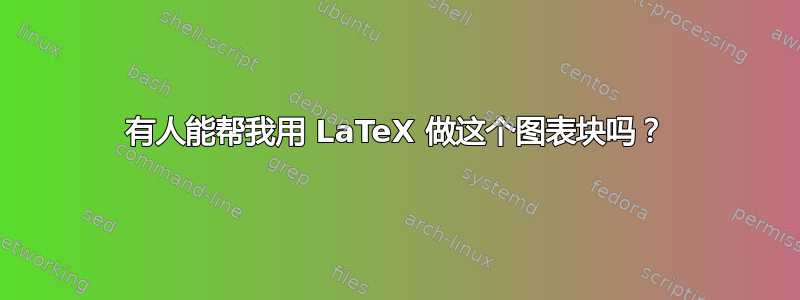
这是我的尝试,我不擅长 LateX 编码:
\documentclass{article}
\usepackage{tikz}
\usetikzlibrary{shapes,arrows}
\begin{document}
\tikzstyle{block} = [draw, fill=white, rectangle,
minimum height=3em, minimum width=6em]
\tikzstyle{sum} = [draw, fill=white, circle, node distance=1cm]
\tikzstyle{input} = [coordinate]
\tikzstyle{output} = [coordinate]
\tikzstyle{pinstyle} = [pin edge={to-,thin,black}]
\begin{tikzpicture}[auto, node distance=2cm,>=latex']
\node [input, name=input] {};
\node [sum, right of=input] (sum) {};
\node [block, right of=sum] (spacecraft) {spacecraft};
\node [block, below right of=spacecraft](thruster controller) {thruster controller};
\node [block, above right of=thruster controller](bruitblanc) {bruit blanc};
\node [block, right of=thruster controller](matrice Ac) {matrice Ac};
\draw [->] (spacecraft) -- node[name=x(k)] {$x(k)$} (thruster controller);
\draw [->] (thruster controller) -- node[name=Tc(k)] {$Tc(k)$} (matrice Ac);
\draw [->] (matrice Ac) -- node[name=Nt(k)] {$Nt(k)$} (sum);
\draw [->] (bruitblanc) -- node[name=Nw(k)] {$Nw(k)$} (thruster controller);
\node [output, right of=sum] (output) {};
\node [block, below of=spacecraft] (calibration torque) {Calibration torque};
\node [block, right of=calibration torque](Measurment Equation) {Measurment Equation};
\node [block, right of=Measurment Equation](RLS Estimation) {RLS Estimation};
\draw [draw,->] (input) -- node {known disturbance} (sum);
\draw [->] (sum) -- node {$e$} (spacecraft);
\draw [->] (spacecraft) -- (calibration torque);
\draw [->] (calibration torque) -- node[name=Nc(k)] {$Nc(k)$} (Measurment Equation);
\draw [->] (thruster controller) |- (calibration torque);
\draw [->] (Measurment Equation) -- node[name=R(k)] {$R(k)$} (RLS Estimation);
\draw [->] (RLS Estimation) -- node [name=Aec(k)] {$Aec(k)$}(output);
\end{tikzpicture}
\end{document}
答案1
或多或少从零开始:-)
- 情况相当复杂...
- 现在使用相对坐标进行节点定位,
- 图片元素的样式定义为
tikzpicture
\documentclass[tikz,
border=3mm,
]{standalone}
\usetikzlibrary{arrows.meta,
calc,
ext.paths.ortho,
fit,
positioning,
quotes,
}
\pgfdeclarelayer{foreground}\pgfdeclarelayer{background}
\pgfsetlayers{background,main,foreground}
\usepackage{bm}
\begin{document}
\begin{tikzpicture}[auto,
node distance = 2mm and 8mm,
box/.style = {draw, text width=#1, fill=gray!30,
minimum height=5ex, align=center},
box/.default = 5em,
dot/.style = {circle, fill, inner sep=2pt, node contents={}},
F/.style = {draw, densely dotted, fit=#1, node contents={}},
lbl/.style = {font=\footnotesize\linespread{0.84}\selectfont, align=center},
sum/.style = {circle, draw, inner sep=5pt, node contents={}},
st/.style = {box,
append after command={\pgfextra{\let\LN\tikzlastnode
\begin{pgfonlayer}{foreground}
\draw[densely dotted]
($(\LN.south) + (0,0.5ex)$) to ($(\LN.north) + (0,-0.5ex)$)
($(\LN.west) + (0.5ex,0)$) to ($(\LN.east) + (-0.5ex,0)$);
\draw[very thick, opacity=0.5]
($(\LN.south west) + (2ex,1ex)$) --
($(\LN.south) + (-1ex,1ex)$) |-
($(\LN.north east) + (-2ex,-1ex)$)
($(\LN.north) + (+1ex,-1ex)$) |-
($(\LN.south) + (-1ex,1ex)$);
\end{pgfonlayer}
}% end \pgfextra
},% end after command
},
arr/.style = {-Stealth, semithick},
every edge/.append style = {draw, arr},
every edge quotes/.style = {font=\footnotesize, align=center}
]
\coordinate (in1);
\coordinate[above=11mm of in1] (in2);
\node (d1) [dot, right=of in1];
\node (sum) [sum, right=of d1];
\node (sad) [box, right=of sum] {Spacecraft Attitude Dynamics};
\node (d2) [dot, right=of sad];
\node (st) [st, above right=of d2] {};
\node (tc) [box, below right=of d2] {Thruster Controller};
\node (d3) [dot, right=of tc];
\node (ak) [box, right=of d3] {$\bm{A}(k)$};
\node[F=(st) (tc)];
\coordinate[above=of st] (aux1);
\draw[arr] (st.east) -|- [distance=-7em] (aux1) -| (d1);
\draw[arr] (in2) node[lbl, left] {$N_d(k)$\\ Anknown\\ Disturbance}
-| (sum);
\coordinate[below=of tc] (aux2);
\draw[arr] (in1) node[lbl, left] {Known\\ Disturbance} -- (d1);
\draw[arr] (d2) -|- (st);
%
\path (d1) edge (sum)
(sum) edge (sad)
(sad) edge (d2);
\draw[arr] (d2) -|- (tc);
\draw (tc) edge["$T_i(k)$"] (ak);
\draw[arr] (ak.east) node[lbl, above right] {$N_k(k)$}
-|- [distance=-15em] (aux2)
-| (sum);
%%
\node (ct) [box, below=12mm of sad] {Calibration torque};
\node (me) [box=10em,
right=of ct] {Measurment Equation\\
$N_c(k) = \bm{A}(k)\bm{T}_c(k)$};
\node (rls) [box, below=12mm of sad.south -| ak] {RLS\\ Estimation};
\coordinate[below=of sad] (aux3);
\coordinate[above=of me] (aux4);
\draw[arr] (d1) |- ([yshift=-5pt] ct.west);
\draw[arr] (d2) |- (aux3) -|- [distance=4em] ([yshift=5pt] ct.west);
\draw[arr] (d3) |- (aux4)
-|- [distance=7em] ([yshift=5pt] me.west);
%
\path ([yshift=-5pt] ct.east) edge ([yshift=-5pt] me.west)
(me) edge (rls)
(rls.east) edge[pos=1, right,"$\hat{A}(k)$"] ++ (1,0)
++ (1.3,0) coordinate (out);
%%%%
\coordinate (aux4) at (in1 |- {$(tc.south)!0.5!(me.north)$});
\draw[dashed, thick] (aux4) -- (aux4 -| out);
\draw[arr, shorten <=2pt] (aux4) --
node[lbl, align=right, left] {Attitude\\ Control\\ System} ++ (0, 1);
\draw[arr, shorten <=2pt] (aux4) --
node[lbl, align=right, left] {Truster\\ Calibration\\ System} ++ (0,-1);
\end{tikzpicture}
\end{document}




